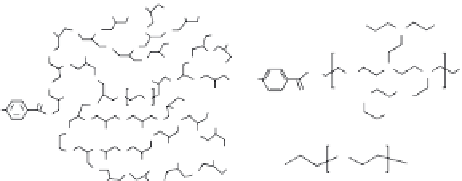Environmental Engineering Reference
In-Depth Information
(a)
(b)
DMAEMA
O
Propargyl bromide
R
Br
N
R
HC
N
N
O
HC
N
+
+
C
C
PEI-N
3
HPG-N
3
HO
N
OH
OH
N
HO
OH
HO
+
N
NH
2
NH
2
O
O
N
N
+
R
HO
O
O
OH
OH
OH
OH
N
N
C
O
O
R
HC
N
N
O
OH
O
HC
N
N
O
O
+
O
NH
2
R
HO
NH
N
CH
N
C
NH
+
O
HO
N
3
O
O
O
OH
C
n
+
NH
N
OH
OH
O
O
NH
O
N
O
4.5
OH
OH
O
N
3
OH
NH
2
O
O
O
O
O
PEG-N
3
OH
PVDF-
g
-P[QDMAEMA-
click
-R]
membrane
O
O
OH
OH
O
O
OH
O
O
OH
OH
OH
O
O
O
OH
OH
OH
OH
OCH
3
N
3
n
O
HO
O
FIGURE 12.5
(a) Schematic illustration of the PVDF membrane after graft copolymerization of DMAEMA via atom trans-
fer radical polymerization (AGET-ATRP) and surface-initiated alkyne-azide click reaction of azido-terminated
hyperbranched polyglycerols (HPG-N
3
) to form the PVDF-g-P[QDMAEMA-click-HPG]. (b) Structure of the var-
ious chemical species used in the study: PVDF = poly(vinylidene luoride); DMAEMA = 2-(
N
,
N
-dimethylamino)
ethyl methacrylate; HPG = hyperbranched polyglycerol; PEI = polyethylenimine; PEG = polyethylene glycol.
(From Cai, T. et al.,
Ind. Eng. Chem. Res.
51, 15962, 2012. With permission.)
12.2 Organic-Inorganic Material Hybrids
Most of the organic-inorganic hybrids are nothing but the combination of organic materi-
als such as polymeric and carbonaceous materials with inorganic nanomaterials. Inorganic
nanomaterials such as Ag, ZnO, TiO
2
, and iron oxide nanoparticles have been used as
antimicrobial agents for removal of pathogens from water. Nanotechnology has a lot of
potential for water disinfection, and recent reviews and topics suggest its importance in
water treatment.
32-34
To address issues such as cost, environmental toxicity, and human
exposure related to the inorganic materials, organic-inorganic material hybrids such as
polymer-Ag, organic-silica, and organic-TiO
2
have been developed as effective materials
for water disinfection, particularly for developing nations.
12.2.1 Polymer-Ag Composites
Silver (Ag
+
or nanoparticle) has a long history of being widely used as an antimicrobial agent
since ancient times.
35
It has been recently shown that silver in its nanoparticle form does not
have any direct “particle-speciic” antimicrobial activity.
36
It is when the Ag nanoparticle
in aqueous solution undergoes oxidation and releases Ag
+
that it is responsible for antimi-
c r o bi a l ac t iv it y.
36
This Ag
+
has a strong interaction with thiols on enzymes and bacterial cell
membranes, causing denaturation and cellular damage respectively, ultimately leading to
cell death. Also, it binds to bacterial cell DNA, preventing cell replication.
35-37
Thus, silver
(Ag
+
or nanoparticle) has a large number of applications, particularly in water disinfec-
tion.
35
Interestingly, despite being effective against a broad range of microorganisms, Ag
has no signiicant side-effects on the human body when present at suficiently low levels.
38
According to the US Environmental Protection Agency (US EPA), the maximum contami-
nant level of silver ions in the drinking water must be <0.10 ppm or mg/L.
39,40
For the controlled release of silver that can offer long-lasting antimicrobial eficacy, sil-
ver has been impregnated into various materials, including polymers, carbonaceous and






